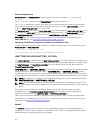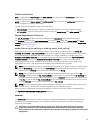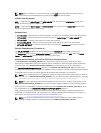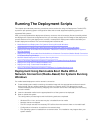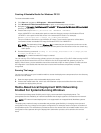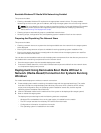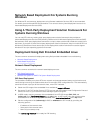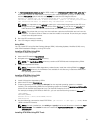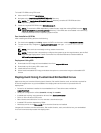
Creating A Bootable Media For Windows PE 3.0
To create a bootable media:
1. Click Start and navigate to All Programs → Microsoft Windows AIK.
2. Click Windows PE Tools Command Prompt to open a command prompt window.
3. Navigate to C:\program files\Windows AIK\Tools\x32 or C:\program files\Windows AIK\Tools\amd64
directory on the system.
4. Execute the script: WINPE3.0_driverinst.bat <WIMPATH> <DTKPATH>
where <WIMPATH> is the destination path to create the directory structure for Windows PE and
<DTKPATH> is the path for the Dell drivers in the extracted DTK toolkit. For example,
WINPE3.0_driverinst.bat C:\winpe_30 C:\DELL\x64\DRIVERS.
This pre-installs the Dell drivers into Windows PE image. The successful execution of the above
commands creates a bootable ISO image for Windows PE 3.0 at <WIMPATH>.
NOTE: The destination folder (C:\winpe_30) is created as part of the process, and must not be
an existing directory. The destination path and the path to the Dell drivers must not contain any
blank space.
5. Run the following command: oscdimg -n -bc:\winpe_30\etfsboot.com c:\winpe_30\ISO
c:\winpe_30\WinPE3.0.iso
WinPE3.0 iso, a media bootable ISO image is created.
You can use any CD or DVD burning software to burn the image onto a CD or DVD. After burning the ISO
image, ensure that it boots from the CD or DVD drive for all the supported Dell systems you plan to
deploy. After it boots, you are advised to test all the tools and scripts on these systems to make sure that
the integration is successful and that there are no issues with hardware components not being
recognized.
Running The Image
You are now ready to use your bootable media to access the deployment components from the directory
structure on the media:
1. Boot the target system with the bootable deployment media.
2. Execute the master batch file, which calls individual task scripts and utilities from the media to
complete the deployment process.
Media-Based Local Deployment With Networking
Enabled For Systems Running Windows
This method provides greater flexibility and is highly recommended in large deployments. The
prerequisites are the availability of network bandwidth and all target systems connected to the network.
NOTE: DTK network-based deployment is not supported from mapped Novell NetWare systems.
This deployment method is easy to assemble and provides great flexibility in changing the scripts and
configuration files. Any change to the system configuration, for example, does not require re‑creation of
the bootable media. This method also provides access to the remote share as writable media. Hence, the
configuration files captured during the deployment automation process can be saved to the remote
share.
57






